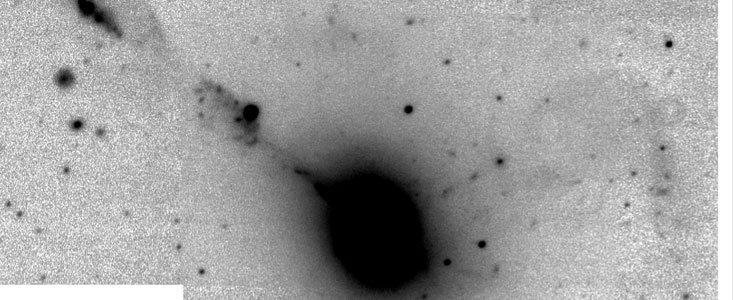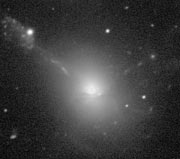Pressemeddelelse
The VLT Records Faint Structures in Colliding Galaxies
31. juli 1998
The unsual galaxy IC 1182 is located in the Hercules cluster of galaxies , a large assembly of galaxies that is seen in the constellation of that name, somewhat north of the celestial equator. It is one of the principal members of this cluster to which the measured distance is of the order of 500 million light-years.
The first VLT 8.2-m telescope (UT1) has recently obtained some spectacular images of this complex galaxy, showing features that have never been seen in this detail before. This has been possible, due to the large light-gathering capacity and excellent optical quality of this telescope. In fact, the UT1 is particularly well suited to (detect and) image very faint, extended structures (low surface brightness features), also in distant objects.
The present photos show two views of IC 1182. They are based on a mosaic of sky exposures with the VLT Test Camera through a red optical filter. The first (ESO Press Photo eso9834a, to the left) shows the entire field that was observed. It is reproduced in "negative" (black stars on a white sky) in order to show the faint outer structures. The second (ESO Press Photo eso9834b, right, in "positive") displays the intricate features in the central area in more detail.
This galaxy possesses a spectacular jet that extends from the centre in the East direction. It is composed of a series of knots of energetic material that move outward from the center. Moreover, there is a broad, but fainter, S-shaped plume on the other side, as well as other "debris" all around. (The circular structure near the right edge of this plume is an instrumental artefact).
The central region of IC 1182 has strongly emitting gas and many clusters of hot, blue stars. Together with the other features, they indicate the very "active" nature of this galaxy. It radiates a lot of energy and ejects a substantial amount of material into the surrounding space at high velocities.
There have been various attempts of explaining this activity, but the most likely one is that of a collision between two galaxies . This view is supported by the observation of two galaxy centers (astronomers refer to them as "galaxy nuclei" ) near each other. This is well visible on ESO Press Photo eso9834b, where the second nucleus is quite obvious, just below to the right (at "4 o'clock") of the main one.
It appears that the structures seen on the VLT images have originated in a collision between a large, elliptical galaxy and another, very gas-rich one, possibly a spiral galaxy. The latter has now been almost completely disrupted by strong gravitational forces, leaving a large amount of gas that is now observed in the extended structures of IC 1182.
Mere information
Technical information : Combination of six 10-min R (red) exposures (seeing 0.6 - 0.7 arcsec) obtained on June 24, 1998, with the VLT Test Camera at three offset pointings. Individual frames were flat-fielded and combined to produce a final FWHM = 0.63 arcsec. The field shown measures 2.4 x 2.1 arcmin (eso9834a) and 1.2 x 1.1 arcmin (eso9834b), respectively. Assuming a distance of 500 million light-years (i.e. that of the Hercules cluster), this corresponds to approx. 350,000 and 175,000 light-years, respectively. North is to the upper right; East is to the upper left.
Om pressemeddelelsen
| Pressemeddelelse nr.: | eso9834 |
| Legacy ID: | Photo 27a-b/98 |
| Navn: | IC 1182 |
| Type: | Local Universe : Galaxy : Type : Irregular |
| Facility: | Very Large Telescope |
| Instruments: | Test Camera |
Our use of Cookies
We use cookies that are essential for accessing our websites and using our services. We also use cookies to analyse, measure and improve our websites’ performance, to enable content sharing via social media and to display media content hosted on third-party platforms.
ESO Cookies Policy
The European Organisation for Astronomical Research in the Southern Hemisphere (ESO) is the pre-eminent intergovernmental science and technology organisation in astronomy. It carries out an ambitious programme focused on the design, construction and operation of powerful ground-based observing facilities for astronomy.
This Cookies Policy is intended to provide clarity by outlining the cookies used on the ESO public websites, their functions, the options you have for controlling them, and the ways you can contact us for additional details.
What are cookies?
Cookies are small pieces of data stored on your device by websites you visit. They serve various purposes, such as remembering login credentials and preferences and enhance your browsing experience.
Categories of cookies we use
Essential cookies (always active): These cookies are strictly necessary for the proper functioning of our website. Without these cookies, the website cannot operate correctly, and certain services, such as logging in or accessing secure areas, may not be available; because they are essential for the website’s operation, they cannot be disabled.
Functional Cookies: These cookies enhance your browsing experience by enabling additional features and personalization, such as remembering your preferences and settings. While not strictly necessary for the website to function, they improve usability and convenience; these cookies are only placed if you provide your consent.
Analytics cookies: These cookies collect information about how visitors interact with our website, such as which pages are visited most often and how users navigate the site. This data helps us improve website performance, optimize content, and enhance the user experience; these cookies are only placed if you provide your consent. We use the following analytics cookies.
Matomo Cookies:
This website uses Matomo (formerly Piwik), an open source software which enables the statistical analysis of website visits. Matomo uses cookies (text files) which are saved on your computer and which allow us to analyze how you use our website. The website user information generated by the cookies will only be saved on the servers of our IT Department. We use this information to analyze www.eso.org visits and to prepare reports on website activities. These data will not be disclosed to third parties.
On behalf of ESO, Matomo will use this information for the purpose of evaluating your use of the website, compiling reports on website activity and providing other services relating to website activity and internet usage.
Matomo cookies settings:
Additional Third-party cookies on ESO websites: some of our pages display content from external providers, e.g. YouTube.
Such third-party services are outside of ESO control and may, at any time, change their terms of service, use of cookies, etc.
YouTube: Some videos on the ESO website are embedded from ESO’s official YouTube channel. We have enabled YouTube’s privacy-enhanced mode, meaning that no cookies are set unless the user actively clicks on the video to play it. Additionally, in this mode, YouTube does not store any personally identifiable cookie data for embedded video playbacks. For more details, please refer to YouTube’s embedding videos information page.
Cookies can also be classified based on the following elements.
Regarding the domain, there are:
- First-party cookies, set by the website you are currently visiting. They are stored by the same domain that you are browsing and are used to enhance your experience on that site;
- Third-party cookies, set by a domain other than the one you are currently visiting.
As for their duration, cookies can be:
- Browser-session cookies, which are deleted when the user closes the browser;
- Stored cookies, which stay on the user's device for a predetermined period of time.
How to manage cookies
Cookie settings: You can modify your cookie choices for the ESO webpages at any time by clicking on the link Cookie settings at the bottom of any page.
In your browser: If you wish to delete cookies or instruct your browser to delete or block cookies by default, please visit the help pages of your browser:
Please be aware that if you delete or decline cookies, certain functionalities of our website may be not be available and your browsing experience may be affected.
You can set most browsers to prevent any cookies being placed on your device, but you may then have to manually adjust some preferences every time you visit a site/page. And some services and functionalities may not work properly at all (e.g. profile logging-in, shop check out).
Updates to the ESO Cookies Policy
The ESO Cookies Policy may be subject to future updates, which will be made available on this page.
Additional information
For any queries related to cookies, please contact: pdprATesoDOTorg.
As ESO public webpages are managed by our Department of Communication, your questions will be dealt with the support of the said Department.


